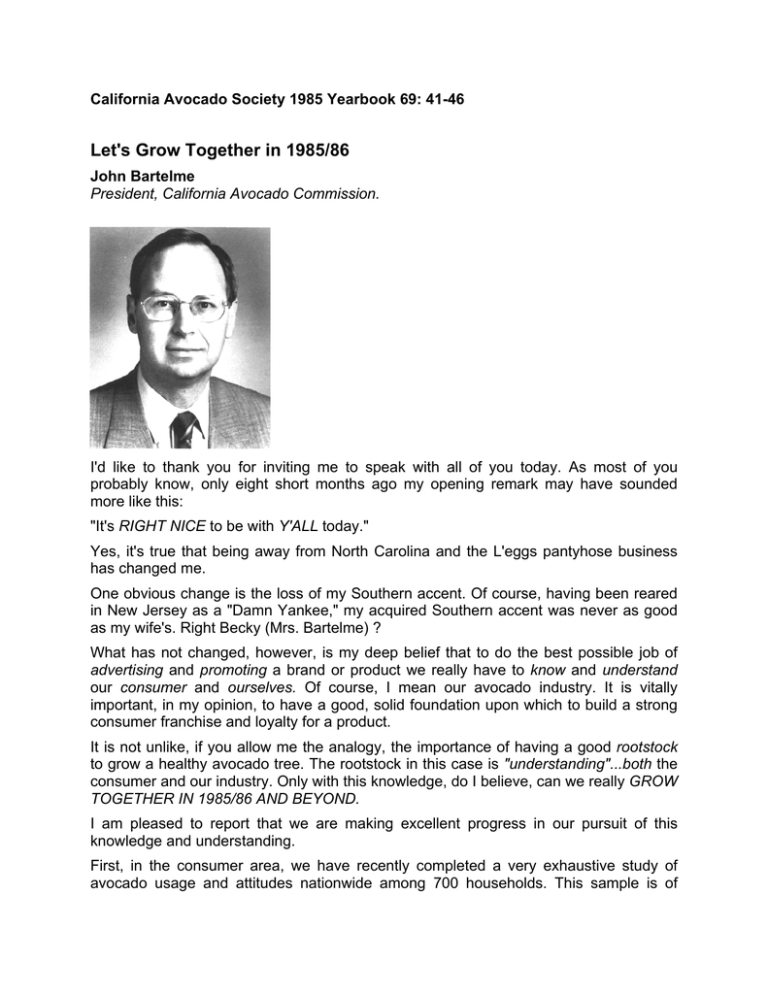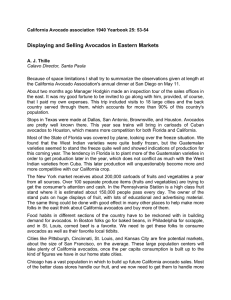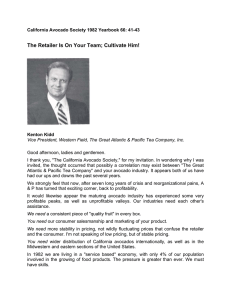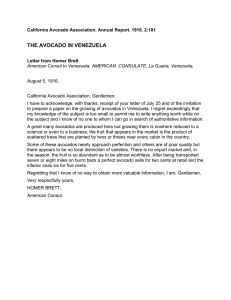Let's Grow Together in 1985/86
advertisement

California Avocado Society 1985 Yearbook 69: 41-46 Let's Grow Together in 1985/86 John Bartelme President, California Avocado Commission. I'd like to thank you for inviting me to speak with all of you today. As most of you probably know, only eight short months ago my opening remark may have sounded more like this: "It's RIGHT NICE to be with Y'ALL today." Yes, it's true that being away from North Carolina and the L'eggs pantyhose business has changed me. One obvious change is the loss of my Southern accent. Of course, having been reared in New Jersey as a "Damn Yankee," my acquired Southern accent was never as good as my wife's. Right Becky (Mrs. Bartelme) ? What has not changed, however, is my deep belief that to do the best possible job of advertising and promoting a brand or product we really have to know and understand our consumer and ourselves. Of course, I mean our avocado industry. It is vitally important, in my opinion, to have a good, solid foundation upon which to build a strong consumer franchise and loyalty for a product. It is not unlike, if you allow me the analogy, the importance of having a good rootstock to grow a healthy avocado tree. The rootstock in this case is "understanding"...both the consumer and our industry. Only with this knowledge, do I believe, can we really GROW TOGETHER IN 1985/86 AND BEYOND. I am pleased to report that we are making excellent progress in our pursuit of this knowledge and understanding. First, in the consumer area, we have recently completed a very exhaustive study of avocado usage and attitudes nationwide among 700 households. This sample is of sufficient size to be projectable for the entire U.S. While I do not want to bore you with the over 200 pages of research findings, I did think you might enjoy hearing about some of the more interesting results and, more importantly, the implications. TO START: • 98% of U.S. households are aware of avocados. And not just the color "avocado green" for appliances. • However, less than half of these households, 44%, currently use avocados. As you might expect, current usage is highest in the West at 89% and second highest in the Southwest at 61%. And yes, Becky, our old area of the country, the Southeast, lags behind at 33%. • Demographically, the current purchaser nationwide is most likely to be college educated, between 35 and 54 years old, and has a household income of $30M. • Avocados are most commonly used in salads and dips. Surprisingly, at least to me, is that only 20% of usage occurs with Mexican meals. As with all research studies, you always get some BAD NEWS and some GOOD NEWS. THE BAD NEWS: There are four main reasons why avocados are not tried, purchased, and/or used more frequently. Consumers: • Do not know how to prepare/use • Have difficulty judging ripeness • Can't always find them • Sometimes too expensive NOW FOR SOME GOOD NEWS: • Consumers are not concerned about calories in avocados. Those on diets and those not dieting are equally likely to purchase and use avocados. • Also, consumers in general do not currently have a problem with the quality of our avocados at retail. Their biggest problem is judging ripeness. • Some even better news from a marketing standpoint, is that among the 44% of current avocado users nationwide, only 11% (about a fourth) are heavy users. (This is not the good news.) The good news is that 3A of the users are medium and light users. And the best news of all is that our research uncovered five leverage points which we can use to encourage light/medium users to purchase avocados more frequently and use them more often. These five are: • Make consumers comfortable with the fruit by making it more familiar and everyday. • Make sure the consumer knows how to select and use the fruit. (Obviously, with preripening, selection becomes much less of a problem.) • Make the consumer feel special and good about serving and using the fruit. • Emphasize the fruit's many uses and versatility through recipe ideas. • Advertise and promote the fruit's velvety texture in addition to the good taste. (The fruit's tactile quality and mouth feel are important attributes.) So, to summarize, the consumer research suggests we do the following: Position California avocados more informally to our target market consumers. We should place them into mainstream meal usage and take them off the pedestal we have placed them on from time-to-time in the past. As someone said recently, we want to change our family tree and become a cousin to the tomato and say goodbye to "Cousin Caviar", One last important thought about this positioning to the consumer. We still want to have our consumers feeling good and special about serving and using avocados, we just don't want them to be for special occasions only. Now that we have talked about our consumer, let's spend a few minutes talking about us, the industry. Mark (Affleck) has already reviewed the excellent progress we have made with AMRIC (Avocado Marketing Research Information Center). I hope you believe, as I do, that we all benefit from this very current, consistent, and constant knowledge about our prices, inventory, shipments, and destinations. This knowledge has a direct impact on our marketing strategies. For example, it's extremely important to know that San Antonio, Texas consumes three times as many California avocados as the entire Southeast...your part of the country, Becky. Another very important industry statistic, of course, is the crop forecast. It drives our annual marketing plan and programs. Because it is so important, we have beefed up our efforts considerably in trying to forecast a more accurate annual crop volume. I am very encouraged by the work Avi Crane and his volunteers around the industry have done the past few months trying to get a better handle on our 1985/86 estimate. Obviously, we are trying to minimize the many variables and thereby maximize our chances for an accurate forecast. My hope is that I can stand up here next year and report that we were successful. I imagine by now that most of you are probably wanting to know how we are going to translate these findings and our new knowledge into actions. (How are we going to grow together in 1985/86?) Let me try to provide some perspective. FIRST, we have to recognize that we have limited resources that have to be employed as effectively and efficiently as possible. SECOND, we have many challenges facing us and many alternative uses for our limited resources. It is not unlike the "Production Research" area where limited funds have to be allocated among many research projects. The challenge is picking those projects that will maximize the return on your investment. The same is true for our overall industry resources. We have to focus our dollars, time, and efforts to maximize the consumption of California avocados. By this time next month we will have reached agreement on the amount of funds we will spend on the major segments of our business. These include, in no particular order: • Consumer advertising and promotion • Trade advertising and promotion • Public relations • Food service • Foreign export • Industry affairs • Administration • Production research THIRD, we need a strong, smart, hard-working team to execute our plans. I feel fortunate that such a team now exists. Brian Starr, Val Weaver, Mark Affleck, Cindy Hitter, Betty Bohrk, our merchandising directors, and the rest of the Commission staff are willing, eager, and able to "MAKE THINGS HAPPEN." We also have a new advertising agency, D'Arcy Masius Benton & Bowles (we call them DMB&B for good reason), that was selected from over 40 contenders that badly wanted to work on our business. We also have a Japanese advertising agency and consultant, along with a food-service consultant in this country, Landry & Associates. Add to this group a supportive Commission Board and committees and we have what I believe to be an excellent team to get the job done. FOURTH, the timing also appears to be ideal for beginning to build a longer-term consumer franchise for our fruit. If you think about it, we will have all the following in our favor: • A new consumer positioning • A better defined target consumer • A better understood marketplace • A new agency and soon a new advertising campaign And finally, • A crop size that should allow us to concentrate more dollars on advertising and less dollars on promotion. No, we are not going to stop promoting, but we do want to begin building more demand for our fruit through a "CONSUMER PULL" rather than a "TRADE PUSH" strategy. The next few months are going to be very busy but exciting ones for the Commission. Not only will we be finalizing our 1985/86 Crop Estimate, but also fine-tuning our 1985/86 Marketing Plans. I am personally looking forward to sharing these plans with you at our annual meetings in early November. I hope today's information has whet your appetite for these meetings. Thanks again for inviting me today. It's been right nice and I hope to see y'all in November. How was that, Becky?



